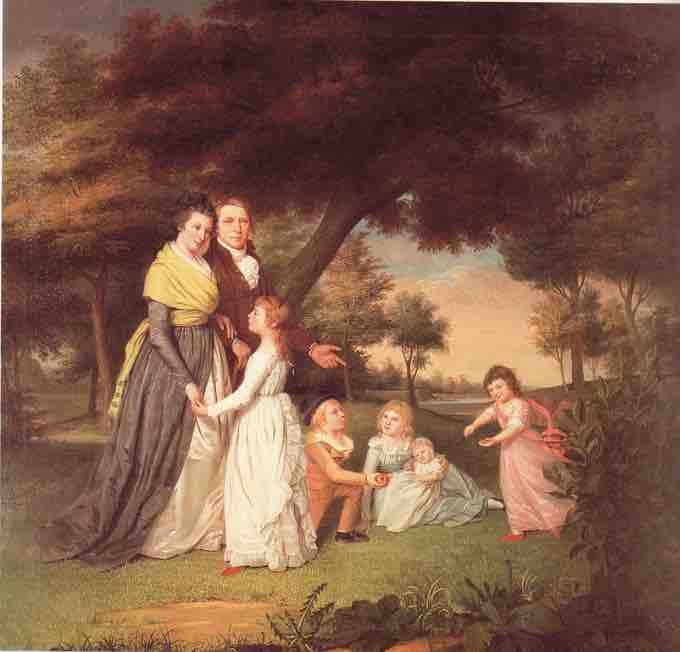Women in the New Republic
"Republican Motherhood" is a twentieth-century term describing an attitude toward the role of women in the emerging United States before, during, and after the American Revolution. It centered on the belief that the patriots' daughters should be raised to uphold the ideals of republicanism in order to pass on republican values to the next generation. "Republican Motherhood" describes a kind of civic duty.
Development of Republican Motherhood
The early seeds of the concept are found in the works of John Locke, a notable eighteenth-century philosopher. Rather than adhering to the traditional sexual hierarchy promoted by his contemporaries, Locke believed that men and women had more equal roles in a marriage. Women were expected to focus on domestic issues, but Locke's treatises helped to engender an appreciation for the value of the domestic sphere and were influential in highlighting the important role of women in society.
Women were expected to help promote the values of republicanism; as intimate and concerned observers of young children, they had a special role in raising the next generation to value patriotism and to sacrifice their own needs for the greater good of the country. Because of this special role, women were permitted to receive more of an education than they previously had been allowed. Abigail Adams advocated for women's education, as demonstrated in many of her letters to her husband, President John Adams.

Abigail Adams
For the most part, women were excluded from the political realm during this era; however, a few women, such as Abigail Adams, entered the political arena as public figures.
Many Christian ministers actively promoted the ideals of Republican Motherhood. They believed this domestic role—rather than the more public roles promoted by Mary Wollstonecraft and her contemporaries—was the appropriate path for women. Traditionally, the Christian religion viewed women as morally inferior to men, especially in the areas of sexuality and religion. However, as the nineteenth century drew closer, many Protestant ministers and moralists argued that modesty and purity were inherent in women's natures, giving them a unique ability to promote Christian values among their children.
By the early nineteenth century, towns and cities were making new opportunities available for girls and women. Influential, too, at this time were the writings of Lydia Maria Child, Catharine Maria Sedgwick, and Lydia Sigourney, who, by equating a successful republic with virtuous families, portrayed Republican Motherhood as a principle that united both state and family. By the 1840s, these New England writers became respected models and were advocates for improving education for females. Greater educational access included making subjects of classical education (such as mathematics and philosophy), which were once studied only by males, integral to curricula at public and private schools for girls.
Analysis of Republican Motherhood
The period of Republican Motherhood is hard to categorize in the history of feminism. On the one hand, the concept reinforced the idea of a domestic women's sphere separate from the public world of men. On the other hand, it encouraged the education of women and imbued their "traditional" sphere with a dignity and importance that had been missing from previous conceptions of women's work.
Historians are divided on the question of whether Republican Motherhood implied that women were on a path toward political equality at the founding of the United States, or whether it signified a new but subservient role for women in the new republic. The idea of a mother as a key force in the preservation and advancement of democracy can be seen as elevating women to politically vital citizens; however, it also can be seen as a reinforcement of traditional women's roles, as it did not encourage women's influence beyond the home.
Although the notion of Republican Motherhood initially encouraged women in their private roles, it eventually resulted in increased educational opportunities for American women, as typified by Mary Lyon and the founding in 1837 of Mount Holyoke Female Seminary (later renamed "Mount Holyoke College").
Educated Northern women became some of the strongest voices and organizers of the abolitionist movement, which blossomed in the 1830s and 1840s. Working on civil rights for enslaved people caused women to want more power for themselves, giving rise to the Seneca Falls Convention of 1848 and the women's rights movement in the United States. Women worked for suffrage, property rights, legal status, and child custody in family disputes. Though an analysis of Republican Motherhood highlights its complexities, it was undoubtedly an influence on later women's-rights movements.

Republican mothers
This painting by James Peale depicts a Revolutionary War-era family. Republican Motherhood required a woman to make an important contribution to the republic by training her children (particularly her daughters) to uphold republican values and pass them on to the next generation.